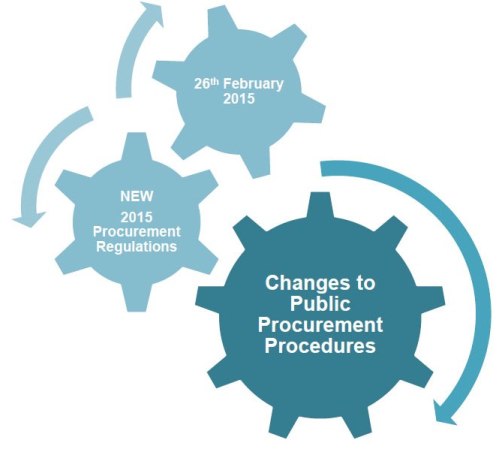The new 2015 Procurement Regulations came into force on the 26th February 2015. They contain many changes that affect public sector tenders.

Government’s Aims
“For contracting authorities, this means being able to run procurement exercises faster, with less red tape, and more focus on getting the right supplier and the best tender.
“And for suppliers, the process of bidding for public contracts should be quicker, less costly, and less bureaucratic, enabling suppliers to compete more effectively.”
Guide to Main Changes in the 2015 Procurement Regulations
Here are the main changes relating to new 2015 Procurement Regulations.
Helping SMEs
Vince Cable set a target of 25% of public contracts to go to SMEs. The initiatives below are very helpful in that respect:
- Contracting authorities urged to break contracts into smaller lots to help SMEs take part.
- A cap on required turnover ratio to help smaller businesses take part in bidding. Authorities cannot set company turnover requirements at more than two-times contract value (except when justified).
The previous ‘turnover yardstick’ was that a contract should not represent more than around 30% of a bidder’s turnover. (But I’ve seen 10-20% at times!) So raising it to 50% is a big change. In light of this, our Fit to Tender Check-list has been updated.
Selection of Suppliers
- Simpler process of assessing bidders’ credentials through greater use of supplier self-declarations.
- Only the winning bidder has to submit certificates and documents as proof.
- Poor performance under previous contracts is permitted as grounds for exclusion (for up to 3-5 years).
- Full-life costing can considered when awarding contracts. e.g better value for money over the long-term despite initially appearing more expensive.
Anything that reduces the amount of work involved in tendering is welcome. Excluding poor performers should help the ‘good guys’. Whole-life costing is interesting; it should encourage more effective long-term solutions but these could be above an authority’s budget.
Procedure Changes
- ‘Below Threshold Contracts’ do not require PQQs. (Thresholds vary depending on authorities and type of procurement).
- Supplier Questionnaires (SQ)s replace PQQs for lower thresholds. They are much simpler and form part of the tender submission. As opposed to be pre-tender.
- Using preliminary market consultations with suppliers to help improve specifications, outcomes and procurement times.
- Statutory minimum time limits for suppliers to respond to adverts and submit tenders reduce by a third. (Longer time limits are still permitted as required).
- Electronic versions of the procurement documentation available via the internet when the OJEU contract notice is published. This compensates for shortened time scales.
Removing PQQs from smaller contracts is good. But authorities still need to carry out some sort of suitability checks or qualification. Hence including SQs within the invitation to tenders (ITTs). Having ITT documents available at OJEU advert stage assists with ‘bid or no bid’ decisions and saves wasted effort.
Innovation Partnership Procedure
The new 2015 Procurement Regulations adds a new award procedure – the Innovation Partnership Procedure:
- Open Procedure: Anyone may respond to an OJEU advert and submit a tender for the contract.
- Restricted Procedure: Advert responses are short-listed and only those invited to to tender can bid for the contract.
- Competitive Dialogue Procedure: Advert responses are short-listed. The contracting authority enters into dialogue with potential bidders to develop one or more solutions for its requirements. Chosen bidders will be invited to tender. The new regulations offer more opportunity to use this procedure (see 5).
- Competitive Procedure with Negotiation: Only those selected from the advert responses can submit an initial tender for the contract. The contracting authority may then open negotiations with tenderers to find improved offers. The new regulations offer more opportunity to use this procedure (see 5).
- Innovation Partnership Procedure: A selection is made from those who respond to the advert. The contracting authority then uses a negotiated approach. Suppliers are invited to submit proposals to develop innovative solutions to meet a need for which there is no suitable existing ‘product’ on the market. The contracting authority is allowed to award partnerships to more than one supplier
This new “Innovation Partnership” procedure is intended to encourage creativity and improvements. Suppliers will bid to enter into a partnership with the authority and develop a new solution (product or service). This must be welcomed as it offers suppliers the chance to work outside of current constraints. Of course, the authorities should benefit from innovative improved solutions.
If you want support with tendering, contact us for an informal discussion to see if we can help you.
Summary
I’ve reported on these proposals and the Lord Young Report a few times over the years. There appears to be a real effort from Government to try and help SMEs win more public sector contracts.
- Smaller lots and lower turnover ratios allows SMEs to compete against larger businesses.
- Providing documents only if you win makes life easier.
- Removing PQQs for low-value contracts simplifies the bidding process.
- Shorter deadlines but with adverts linking to ITT documents should actually extend the time available to prepare bids. Knowing the ITT contents can also help with ‘bid / no bid’ decisions.
- The new Innovation Partnership procedure should help innovative companies to compete with new solutions.
- Simpler SQs combined into the ITT instead of a PQQ stage saves a lot of time.
Once the UK completes Brexit, the government will still need to ensure it procures goods and services correctly. But it will be free of EU Regulations. What else can the Government to do make tendering easier?

